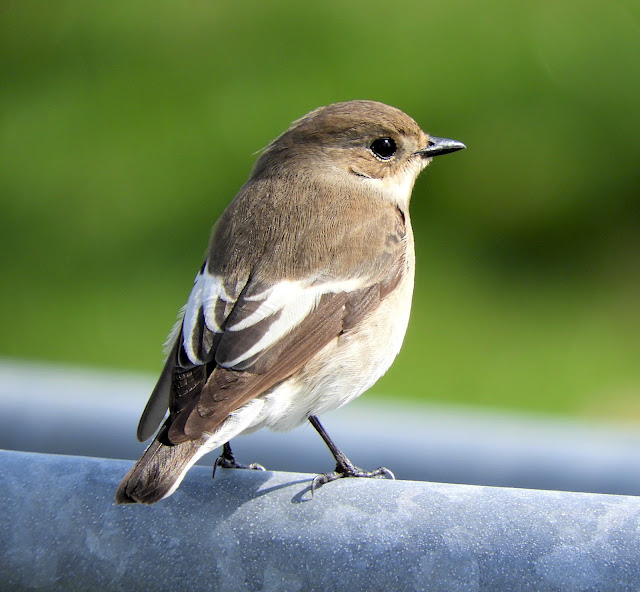Overcast with one or two sunny spells and a strong easterly wind for most – slackening somewhat in the late afternoon.
A very quiet bird day today due to the winds – again most birds were found low down on the west cliffs, thick scrub on the east and in the lee of drystone walls.
Highlights included a decent passage of Swallow throughout the afternoon, despite the winds. Here, 120 birds were recorded pushing north, along with smaller numbers of House Martin (10) and Sand Martin (6).
Other migrants included a White Wagtail on High Street track, a handsome male Ring Ouzel next to Old Light, eight Blackcap, singles of Whitethroat and Willow Warbler and a small movement of Goldfinch and Linnet along the west in the afternoon.
 |
| White Wagtail, High Street track, 21st Apr © Dean Jones |
April 22nd
Another very windy day, particularly in the morning, easing by the evening. Lots of sunshine (though still rather chilly due to the easterly winds) and clear skies throughout.
Despite Millcombe resembling a tree-lined wind tunnel first thing, there were a few newly arrived migrants sheltering and foraging within the Blackthorn in the lee of the Ugly. These included the second Reed Warbler of the year, a reeling Grasshopper Warbler, four Whitethroat, a female Ring Ouzel and a handful of Blackcap, Willow Warblers and Chiffchaff.
On the more sheltered west coast, hirundines once again stole the show with hourly counts of over 530 Swallow, 30 Sand Martin and 34 House Martin zooming north from around 12:00 onwards.
Other migrants of note included 41 Wheatears – among them at least six Greenland race birds, a stunning male Whinchat sheltering behind the wall on route to the Old Light, a fly-over Tree Pipit in South West Field, a fly-by Yellow Wagtail in Jenny’s Cove, a lone Whimbrel in lower Lighthouse Field, a Ringed Plover on Ackland’s Moor and the first Siskin of the year, calling over Millcombe in the evening.
 |
| Male Whinchat, Old Light track, 22nd Apr © Dean Jones |
 |
| There have been lots of handsome male Linnets singing in South West Field throughout this period, 22nd Apr © Dean Jones |
One other bird that's worthy of mention was a very unusual looking Whitethroat in the scrub near the ‘Steps of Doom’. At first glance – as the bird's small dark head popped out from the undergrowth – Zoë Barton and myself thought we had found a nice Lesser Whitethroat. After a few seconds however the bird then revealed itself further, displaying a chestnutty colouration to its wings and a chestnut-brown back, similar to that of a Common Whitethroat.
Alarm bells then started to ring as I realised I was potentially looking at something unusual, as I couldn’t recall ever seeing such a small Common Whitethroat (a female Whitethroat nearby enabled a size comparison) with such a dark head colouration. The bird was very restless, jumping around the scrub in search of a meal in a rather frantic fashion, but luckily we managed to take a few record shots (see below) to help with identification.
 |
| Common Whitethroat – note the dark head colouration, 'Steps of Doom', 22nd Apr © Dean Jones |
 |
| Common Whitethroat, 'Steps of Doom', 22nd Apr © Dean Jones |
 |
| Common Whitethroat, 'Steps of Doom', 22nd Apr © Dean Jones |
 |
| Common Whitethroat, 'Steps of Doom', 22nd Apr © Dean Jones |
As you can see from the images, the colouration, particularly the head pattern, somewhat resembles a Spectacled Warbler (even more so in the field), a species which we were considering when watching the bird. Upon closer inspection however, you can see that this bird has a long primary projection compared to its tertial length (Spectacled Warbler should only be a third of the length, and Whitethroat more than half), dark centred greater coverts (though this wasn’t always obvious as you can see from some of the images – again resembling Spectacled Warbler), and was an all-round (bill, underparts and legs) duller bird than you would expect for a male Spectacled Warbler in breeding plumage.
Despite the bird not turning out to be a potential mega for the island and for the county [only one previous Spectacled Warbler, on Dartmoor in June 1999], this Whitethroat was an interesting bird nonetheless. I later shared these images with a number of friends and all agreed that they had never seen a Whitethroat quite like this one – thus I thought I would share the experience here. It just goes to shows that there is always something new to learn and see – even with familiar species!
April 23rd
A beautifully sunny and clear day, with strong and chilly easterly winds in the morning dropping to nothing by the late afternoon.
Highlights included the first three Spotted Flycatcher of the year (all in Millcombe) and a fantastic variety of other migrants including a Curlew (the first of the spring also), two Whimbrel, two female Pied Flycatcher, a stunning male Redstart, 18 Willow Warbler, three Chiffchaff, 32 Blackcap, eight Whitethroat, a single Garden Warbler, five Sedge Warbler, 46 Wheatear (of which there were at least nine Greenland birds), a female Whinchat on the Pointless Wall, two Song Thrush and a Reed Bunting in Millcombe.
 |
| Spotted Flycatcher, Millcombe, 23rd Apr © Dean Jones |
 |
| Female Pied Flycatcher (and below), High Street, 23rd Apr © Dean Jones |
 |
| This lady was very happy to have lots of photos taken of her © Dean Jones |
 |
| Sedge Warbler, Terrace, 23rd Apr © Dean Jones |
Hirundines also put in another great show with 780 Swallow, 130 Sand Martin and 11 House Martin logged.
No comments:
Post a Comment